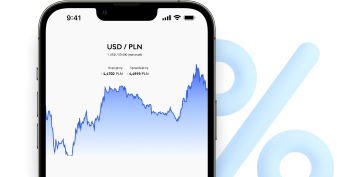Exchange rate DKK - Danish krone
The Danish krone is the official currency of Denmark, Greenland and the Faroe Islands. One krone is subdivided into 100 øre.
Select currencies and check rates
Live rates.
Update: 30s
| Currency | Buy | Sell | Name | Currency code |
|---|---|---|---|---|
| DKK EUR | 0.1321 | 0.1359 | Danish krone | 1 DKK |
Danish krone exchange rate - chart
Last currency comments
Over 900 000 reviews
Customers rate us 4.9/5.0.*
Start saving today
Forget about unfavourable rates and hidden fees. See how much you can save. Create a free account and start converting currency online.
Open account for freeDanish krone
The Danish krone (DKK) is the official currency of Denmark. In addition to the official symbol, the Danes also use the abbreviation "kr" to denote it, derived from the word "krone", meaning crown.
The Danish krone - where is it used?
DKK is the official currency of Denmark and its dependent territories. Therefore, it is also worth checking the Danish krone exchange rate when travelling to the Faroe Islands and Greenland. In Denmark, you can also successfully pay in euros or convert them to DKK directly on the spot. However, it is worth buying a Danish krone before departure. Its purchase should not be a problem, and if you use our portal, it will result in savings thanks to the attractive DKK to EUR exchange rate.
The history of the Danish krone
Already in the Middle Ages Danes used gold kroner. Then the Danish thalers became dominant, but it was only until 1873 when Denmark, together with other Scandinavian countries, concluded a monetary union, introducing a common currency - the krone (English - crown). The Scandinavians used them until 1914, when they pursued their separate currency paths, although each country retained the main currency name, adding a second segment to denote nationality. This was when the Danish krone came into circulation. At first the DKK exchange rate was closely dependent on the price of gold, of which it contained an admixture, and later on it was tied to the pound sterling.
The Danish krone - key information
50, 100, 200, 500 and 1000 are the Danish krone (DKK) banknotes' denominations. The series issued in 2006 features famous bridge structures, and the one with the highest value shows the 18-kilometre-long Great Belt Fixed Link, a structure that connects the islands of Zealand and Funen. The reverses, on the other hand, feature famous and valuable monuments of Denmark. The DKK banknotes are issued in series. The series from 1952 depicted Danish artists and landscapes, and, for example, the 1972 series showed images of so-called everyday citizens of the country. On the other hand, in 1997 the money appeared with famous Danes, e.g. Nobel Prize winner, physicist Niels Bohr or writer Karen Blixen. What is rare nowadays, coins with face values of 1, 2 and 5 kroner have round holes in the middle. This is a nod to old times and the custom where coins were strung and worn on a strap. DKK also comes in coins of 10 and 20 kroner. The unit of Danish currency is divided into 100 öre. The smallest denomination of Danish currency is the 50 öre coin.
What determines the Danish krone exchange rate?
Both the parameters of the Danish economy and the actions of the central bank do not give grounds to worry about the stability and quotations of the Danish currency. The DKK is one of the least volatile currencies on the currency market, even though it is not listed in the first row of the so-called safe havens, along with the franc, the yen or gold. The Danish krone conversion rate is pegged to the euro, i.e. it remains at a fixed level between the DKK and the euro, with maximum fluctuations of plus or minus 2.25%. In practice, the differences are no more than 0.50%. This is one of the reasons why the exchange rate of the Danish krone depends on the condition of the most powerful economies of the Old Continent. Denmark has decided to take this step when preparing to adopt the common European currency, which has not happened yet. Interestingly, it is also worth knowing that in addition to the euro, the Danish krone is also rigidly pegged to the Faroese krone, which operates there in parallel to the DKK. The exchange rate has been fixed at 1:1.






























